Americans big guns
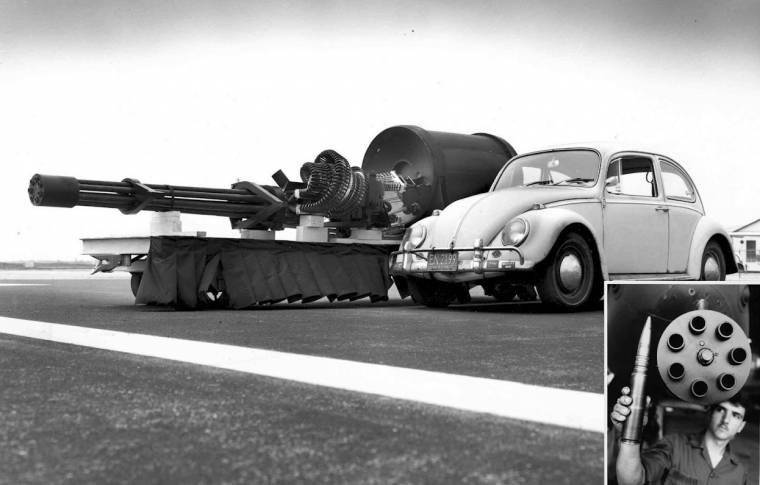
This is not Photoshop. It looks like a 30 mm aviation GAU-8A gun, which is armed with the American A-10 attack aircraft.
In fact, the A-10 attack aircraft are built around this gun. His entire layout is subject to the need to lift this monster into the air and not fall apart when firing from it.
A typical example. A very strange and unusual placement of engines in the tail of the aircraft is a necessary measure in an attempt to prevent them from stopping due to falling into the air intakes of powder gases when firing. Well, so stupidly done. When carrying out (in 1974 in March) flight fire tests of the GAU-8A cannon mounted on an A-10A aircraft, abnormal operation of the aircraft’s engines was observed, caused by the ingress of gunpowder gases generated during firing. Therefore, we had to add two nozzles in the nose of the plane, into which, when fired, compressed air is supplied in order to blow away the powder gases to the side.
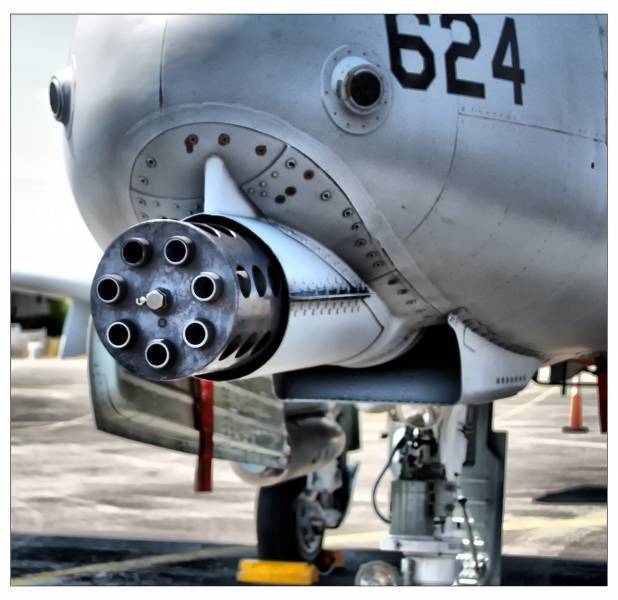
Are you funny? Me too.
To ensure a more complete combustion of the propellant composition inside the trunks (to eliminate the burning of powder gases in front of the aircraft), potassium nitrate is added to it. This additive is either injected into the propellant or in a separate plastic bag is embedded in the cartridge. However, it helps not so much:
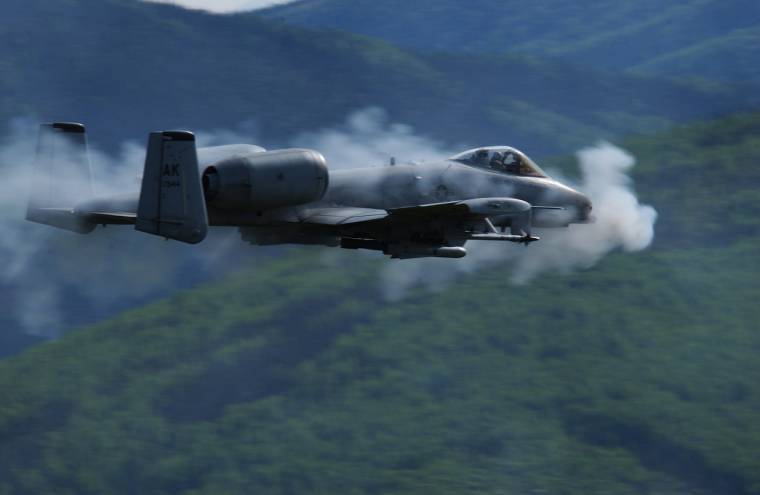
During the operation of the A-10A aircraft, it was found that when firing from a gun, powder gases are still sucked into the engine, and unburned powder particles are deposited on the blades of a fan and engine compressor. The accumulation of unburned particles after every 1000 shots reduces engine thrust by 1%. The overall reduction in thrust with a nastrelom reached 10%, which increased the likelihood of disruption of the flow from the blades of the compressor and the stop of the engines.
To reduce the likelihood of disruption of the flow from the compressor blades, the following restrictions were introduced:
- Ignition devices (torches at the air inlet) that ignite unburned powder particles were built into the engines of the aircraft in 1981;
- firing from the gun is allowed only in short bursts and only with low (2100 rds / min) rate of fire;
- mandatory flushing of the engine after every 2600-3000 shots with soap and water to remove soot from the fan and compressor blades.
In order for you to appreciate how tightly the GAU-8A gun fits into the А-10 plane, I’ll let you know that this gun comes in two versions: for a two-seater and a single-seater. Compared to the gun system of a single-seat aircraft, the ammunition store for the two-seater is shortened from 492 to 408 mm. Otherwise, the second person would have nowhere to plant.
The development of the 30-mm seven-barreled GAU-8A gun was launched by General Electric in 1971. The gun was designed specifically for the A-10A attack aircraft. In February, 1974 was launched by General Electric to manufacture a pre-production lot of GAU-8A guns. In May, the 1975 was successfully completed flight fire tests of the gun GAU-8A. The test results showed that the installation and use of the gun on the A-10A did not adversely affect the aircraft’s handling. One of the main factors checked by the compatibility test of the gun with the aircraft was the effect of recoil force on the aircraft when fired. According to calculations, the recoil force of the gun was supposed to be about 7700 kg, in fact, when fired, it was about 6800 kg.
During the tests, firing was conducted with a high and low rate of fire at flight speeds of 300-740 km / h at altitudes from 850 to 3900 m and overload aircraft up to fourfold.
The GAU-8A cannon is located along the longitudinal axis of the aircraft and is offset to the left side on the 0,3 m. It works according to the Gatling principle, has a hydraulic external drive and a cartridgeless feed system. A drum magazine holds 1350 cartridges. The spent cartridges are assembled onboard the aircraft in a drum-type container and can be reused.
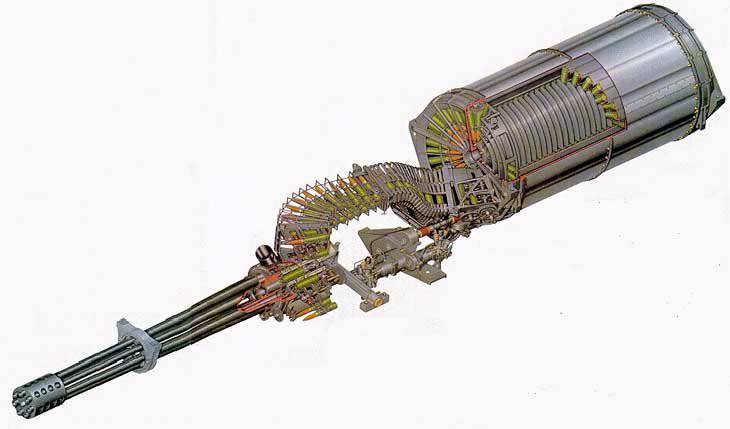
You ask: why is all this needed?
The fact is that in 1971 it was discovered that the Soviet Tanks can be successfully hit when attacking from above with armor-piercing shells of 30 mm caliber. Well, the tank has thin armor from above - and therefore it can be pierced with such a caliber.
But in order for an airplane flying over the battlefield over enemy tanks not to be knocked down, it must fly fast. And this requires a high rate of fire to get at least 1-2 shells into the tank at that speed.
The drive of the barrel unit and the power supply system is powered by two hydraulic motors using the hydraulic system of the aircraft. Both engines together generate power in 77 hp. (57,4 kW) required to fire at maximum rate of fire 4200 shots / min. If one of the motors fails, the shooting is carried out at a speed of 2100 rpm.
Well, in general, the United States built such joy and were pleased. But not for long - because they raskkovany Uralvagonkolkhoz something podhimichili in the layout of the tank, hung additional screens and armor, and the tank 30-mm projectile from above to stop breaking. The use of depleted uranium cores also did not save the situation - but it sharply increased the price of the projectile. The economics of the A-10 plane went the same way the US economy went - in the ass.
During Operation Desert Storm, A-10 attack aircraft from the United States Air Force used PGU-14 / B depleted uranium shells. 148 aircraft based in Saudi Arabia, performed 8077 combat missions. XUUMX PGU-783.514 / B 14 and almost 200 thousands of incendiary projectiles were spent. Based on the fact that each PGU-14 projectile contains about 300 of depleted uranium, the US Air Force scattered around the Persian Gulf about 259 tons of OU.
In theory, in such a quantity it was possible to destroy all the armored vehicles of all the Gulf countries. However, the real success of the shooting was almost zero - and this despite the fact that the targets were heavily outdated tanks. In fact, the gun GAU-8A signed her impotence against the tanks.
As a result, the United States ended up with an attack aircraft, the main weapon which does not perform the main task of the aircraft. The whole system began to look unusually stupid - since such a monstroid gun is simply not needed for firing at enemy infantry and BTR am, there is quite enough 23 mm caliber and much lower projectile kinetics, and it was almost useless against tanks.
Then, A-10 was equipped with command and control equipment for anti-tank missiles Hellfire. However, the cannon that has become useless from an airplane cannot be removed - at least the alignment of the aircraft will be disrupted. And A-10 carry an almost useless, multi-toned piece of iron, and cannot take any significant amount of rockets.
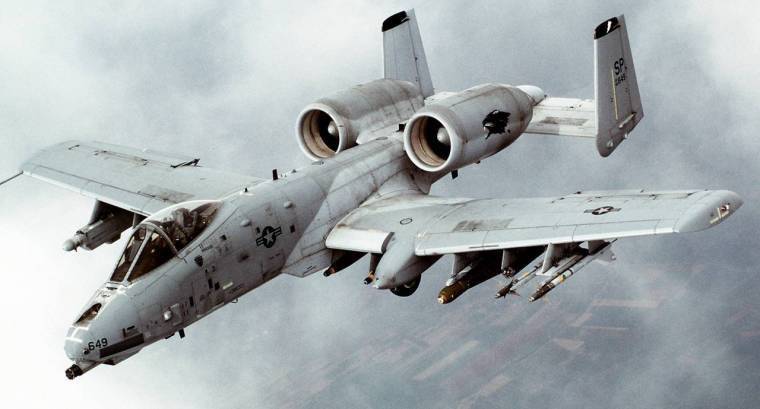
See the photo? To take so many missiles, the A-10 flies without any shells at all to the main cannon.
PS The funny thing is that the cunning Russians also have an 30-mm aircraft gun - GSH-6-30 (TKB-635):
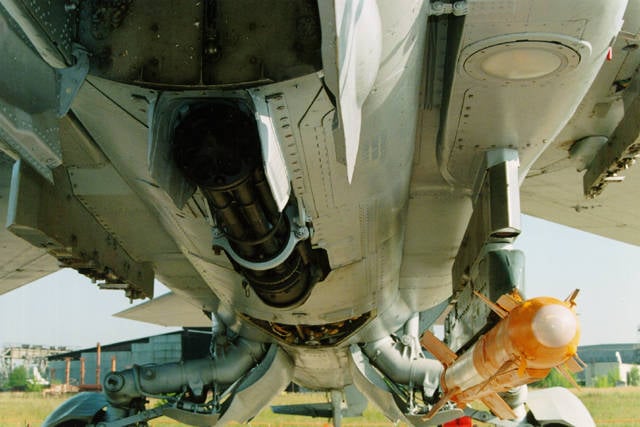
As you can see, at the rate of firing at 5000 shots per minute, it is much more compact.
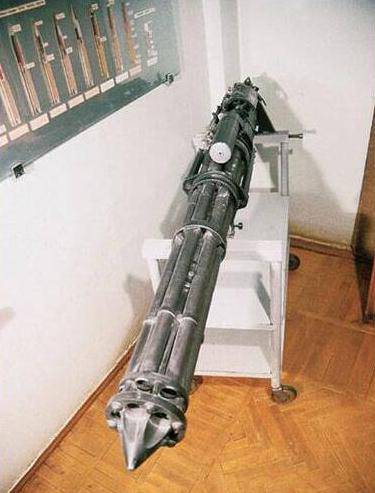
The operation of the gun of the HS-6-30 gun (TKB-635) is based on the principle of using the energy of powder gases. diverted alternately from each trunk. Preliminary acceleration of the barrel assembly at the beginning of each line is carried out with compressed air (pneumatic starter).
The HS-6-30 gun was adopted in 1974 and received the index 9-А-621. The GS-6-30 cannon are armed with Su-24MK (single, 500 ammunition) and MiG-27 aircraft. In the aviation version with low ballistics, GSH-6-30А had a return in 5500 kgf. Shock loads when shooting were very powerful for the design of the aircraft (yet its airframe was a remake of a fairly lightweight fighter). The first shooting made in flight ended with the failure of all the instruments in the cockpit after the queue of 25 shells.
In combination with the sighting system GSH-6-30А had a high accuracy of fire. A factory test pilot, M. Turkin, offered to get into a dispute to get into a white T-shirt fixed on the target and clearly visible, and even to take down his cap on top. After making a couple of visits, he put a queue on the target. It was not possible to determine who won the dispute: the queue scattered the timbered target so that there were not even scraps left.
In the combat parts of the firing of the gun were quite frequent, but always impressive for the pilots themselves - the rolling thunderbolt of the queue, emitting a hundred shells per second, and the recoil shaking through the machine caused an incomparable feeling of power and strength in their hands. No less impressive was the view of the work of the "six arms" from the side: the leading fire plane was enveloped for a few moments with a cloud of flame, from which a fiery downpour stretched to the ground. Usually, two OFZ shells alternated in ribbons through a single BR.
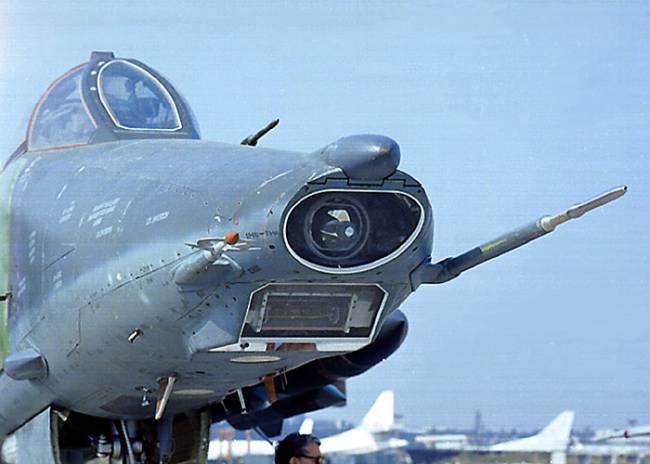
MiG-27 aiming system
In automatic mode, the PrNN-23 aim-navigation complex was used. He gave the necessary corrections and preemptions for the sight, and the aiming was carried out by imposing on the target a mobile aiming mark C-17ВГ, on which the current distance to the object of attack and the sector of the effective range (beginning and ending) of shooting were highlighted. Unlike other machines, a second combat button was mounted on the MiG-27 control stick, specifically for the gun. By the pilots themselves, firing from a cannon was considered more attractive than the bombing or launch of the NAR, which had already exploded after the plane, leaving the attack, and then observed from above as dusty clouds at best. The gun gave a tangible and visible result: immediately after the "emergence" of the aiming mark, the shells went almost to the place where the mark was applied. Thanks to the powerful ballistics and high rate of fire, it was possible to see how the first projectiles of the queue bite into the target. Then I had to take the handle on myself, and the bulk of the volley fell into the target, a fraction of a second behind the aircraft emerging from the dive. The withdrawal was usually performed with a lapel to the side, moving away from the fragments and ricocheting of its own projectiles. Shards from them rose to a height of 200 m and represented a serious danger to the aircraft.
8 August 1988 of the year in 19-m gv. apib in the GSVG after firing on the MiG-XNUMHD of Lieutenant MV Poluektova, the front desk did not release due to the fact that the fuselage was “led” and the flap was jammed. As noted in the report, "the pilot had a high moral and political preparation" and was able to land the plane on the main wheels, put out the speed and touched the nose of the concrete with minimal damage. In 27, the 599 apib of May 15, a similar case occurred with more severe consequences: the localizer was torn from the gun with a burst, the doors shut in, the rack did not come out and the MiG-1990K plowed the nose of the runway, after which the car had to be written off. Occurred "knocking out" gas stations, disconnecting the equipment, refused communication and systems. Some of the cases, for all the seriousness of the situation, bordered on curiosity. In the 27 th 24 air division, on April 18, the MiG-1988 came to the airfield, not only deafening, but also left without PrNK - the cannon line at once cut down all the radio equipment and gyroscopes. In the GSNG 27 of September 2, the MiG-1989 cannon volley led to a complete loss of radio communications - contacts and flying out of the radio were broken off and the printed circuit boards cracked. In 27, the VA in January, 23, gunfire led directly to two incidents: in the 1989, the overspeed fuse caused an almost complete de-energization of the “board” with a failure to control the stabilizer, flaps, chassis, and MRCs, and a week earlier in the next 58. Apib MiG-266K returned from a flight without a lantern cover, torn when fired (emergency locks themselves opened, releasing the lantern into "free flight").
Even against this background, the case that occurred in the 24 March 29 1989 division of the year looked unique: the dashboard panel fell apart at the exit from a dive after shooting at the pilot's feet, the fixture of which killed itself. Holding the panel hanging on the harnesses with his hand, the pilot flew to the airfield. More than once it happened that the reflector of the sight burst from the blows of the line. The landing lights were split so often that they were removed and replaced with plugs before flying into the shooting area. The introduction of deflector shields did not completely save the situation, which required that the Instructions be clarified to the pilot: after night firing, landing was allowed only on the runway-illuminated floodlights.
But on the other hand, our gun weighed only 149-160 kg, and the GAU-8A weighed almost 300 kg, plus the drive systems, without which our gun managed.
In the end, the 30-mm gun was considered excessively powerful and was replaced by a lighter (76 kg total) 23-mm GSH-6-23 gun (TKB-613), which had a rate of firing 9000 shots per minute. She was armed with MiG-27, MiG-31, Su-24, Su-24M aircraft.
The Su fighters (Su-27, Su-30, Su-35, Su-37) use the GSH-301 gun (9A4071K) in the same caliber 30 mm, but single-barreled, with water vapor-cooled barrel. It weighs only 50 kg and has an 1500 firing rate per rpm.
The difference between the Russian and American approach to the 30-mm aircraft cannon is that in Russia this gun has never (since the time of piston aircraft) been considered as the main armament of the aircraft. Hence the consequence that the Russians implemented the cannon into the finished aircraft, and did not make the aircraft under the cannon, and, accordingly, the Russians received the flexibility that the Americans did not achieve.
Well, the Russian anti-attack attack aircraft initially focused on missile weapons.
An attack aircraft capable of fighting small-sized and heavily protected targets (including new generation NATO tanks) was originally intended to be carried out in a double version and equipped with Raduga anti-tank systems, but later the choice was made on the advanced Vikhr anti-tank systems, which could use single plane. As another weapon of the upgraded attack aircraft, the 45-mm perspective gun, moving in a vertical plane, was considered, however, due to the difficulties with working out this system, it was decided to equip the aircraft with a fixed double-barreled gun GSH-30 (30 mm).
The anti-tank attack aircraft is called Su-25TM (or Su-39). Here is this monster:
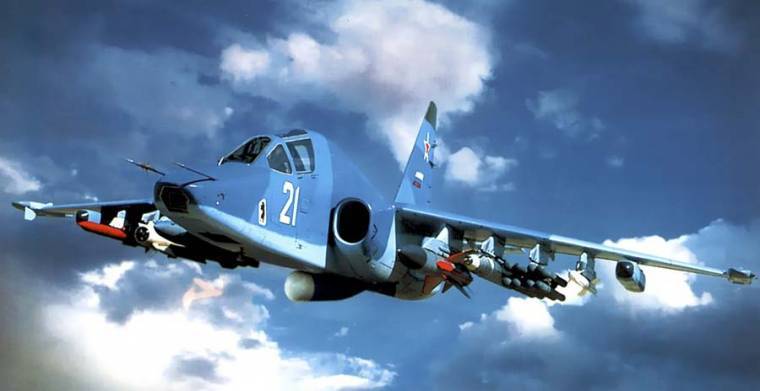
The difference in the combat load with the American is perfectly noticeable.
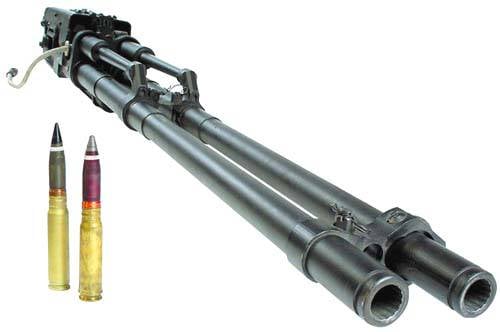
Gun GSH-30
Rate of Fire - 2460 shots per minute. For firing from a GSH-30 gun used 30-mm ammunition with high-explosive-incendiary BFL-30-GSH, tracer OFZT-30-GSH, armor-piercing discontinuous BR-30-GSH and multielement ME (contains 28 bullets in a package and expelling charge) projectiles (mass of projectile 400 g).
Information